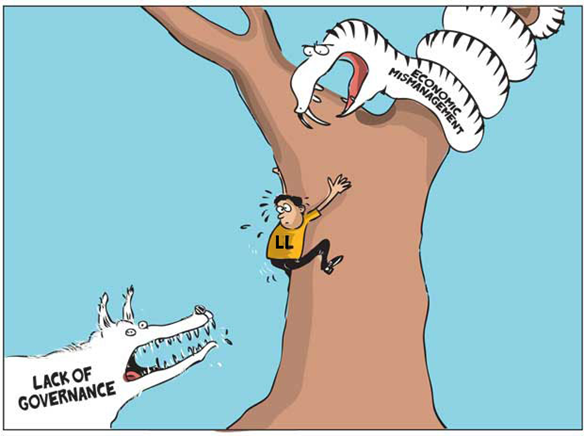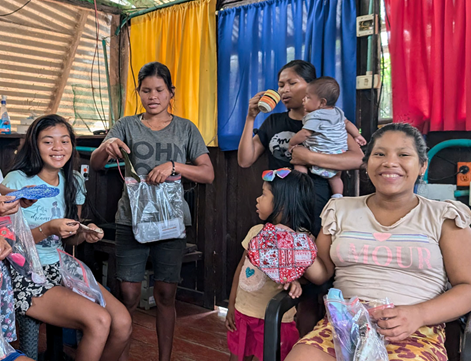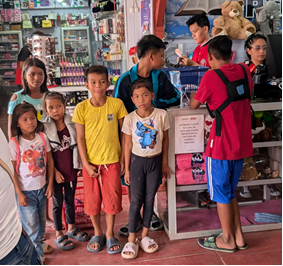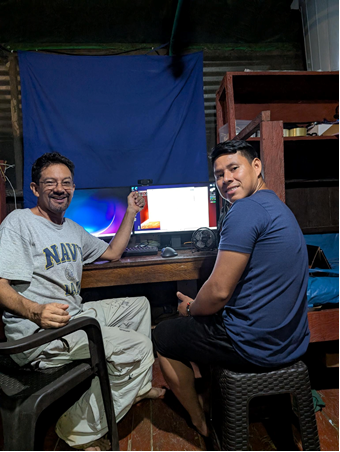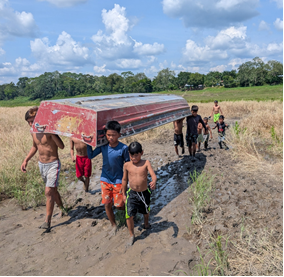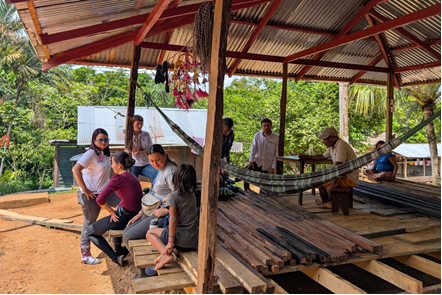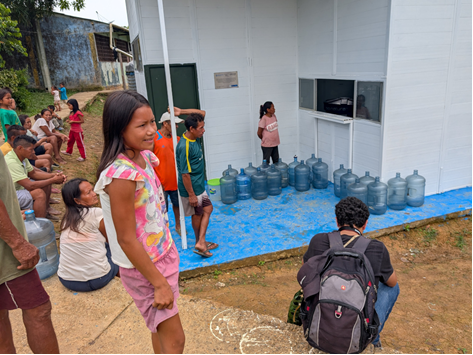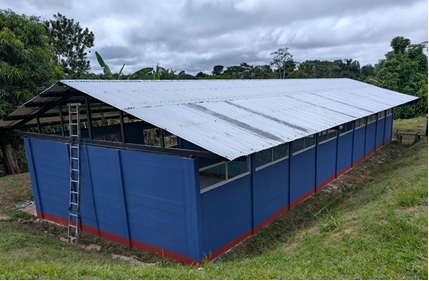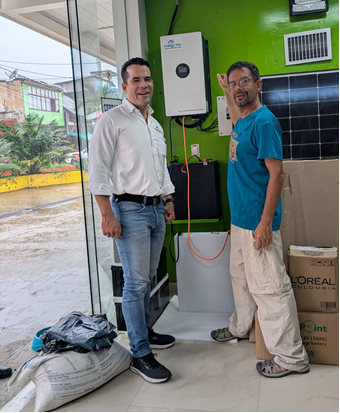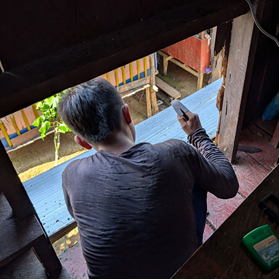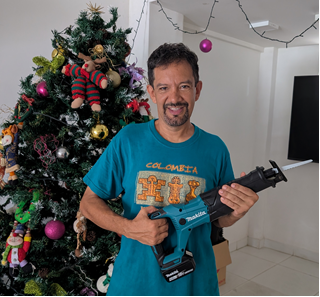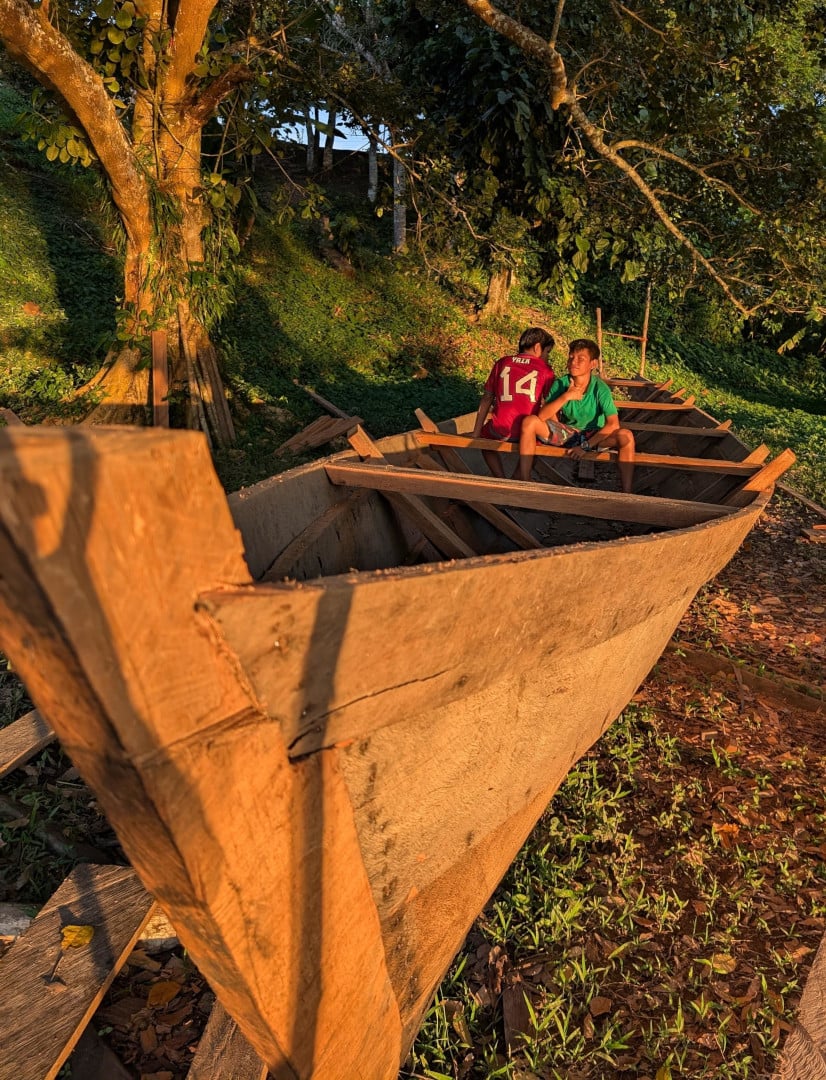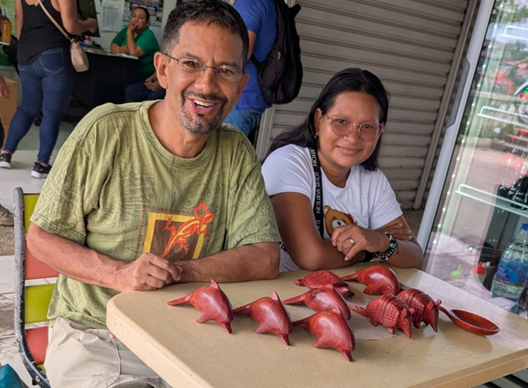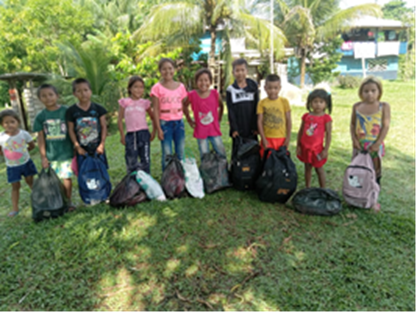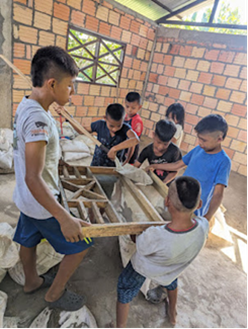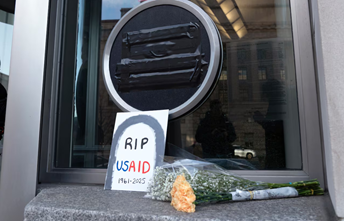Welcome to the spring director's report! A lot has been happening with the project. We hope to bring everyone up to speed on the current developments.
THE GOOD
Health center nears completion
The health center is now ready for use after three years of
work and a total investment of approximately $9,000. Future improvements
include connecting it to La Libertad's electrical system (and eventually utilizing
solar power), constructing a bathroom, replacing the wooden door with a metal
one, and adding furniture, which is planned for later. It is a well-made building
of concrete, metal, and tile. It is ready for community use.
We hope the community appreciates the health center and directs funds towards its continued development. The most difficult parts of planning, transporting, and construction have been finished.
24-hour solar-powered energy and internet
The guesthouse, Gustavo's house, kitchen, and bathroom now
have 24-hour electricity. The electrical system, upgraded to 48 volts,
includes three 550-watt solar panels, a 100 amp-hour lithium battery, and a
3,500-watt pure sine wave power inverter. This system is resilient and
low-maintenance.
While we had hoped to increase the number of solar panels to
six and build a dedicated solar energy building, this will have to wait for the
future. This upgrade in the number of panels and the building will allow
better security, heat management, structural stability, and dependable power
during the heaviest times of the rainy season.
Our internet has been supplying a signal to the villagers
for the past two years. This service helps communication for work,
school, family, and emergencies. Three months ago, we upgraded our
router. The new router doubled the signal range, covering the 12 houses
in our neighborhood and accommodating visitors.
Technical solutions to problems of internet usage
Unfortunately, with the free internet in the village came
increased time on social media, games, and videos. The village youth
spent too much time on the internet and less on school and housework. With an
upgraded router, this problem is solved until the gamer youth can get around
it. The router has settings that allow us to block social media, gaming,
and video sites, which helps improve internet speeds for more essential uses
and happier parents.
Massive repairs and upgrades to the volunteer/guest
house, kitchen, and support buildings
As the water level rose starting last December, we were able
to bring in supplies to make repairs on the project's buildings in La Libertad.
Significant rot and insect damage resulted in holes in the floors and walls,
weakened beams, and a general state of disrepair.
We expanded the kitchen, replaced numerous floorboards,
walls, and supporting beams, repaired leaky roofs, installed new electrical
outlets, switches, and light fixtures, replaced old water pipes, and applied
much-needed fresh coats of paint.
15-meter wooden boat for community use
This year, we helped the community build a 15-meter wooden
boat. We allocated $1,000 to purchase gasoline, oil, nails, other construction
materials, and food for group volunteer meals, with the community providing the
labor.
The boat's size allows passage of up to 40
people or 4 tons of cargo. In April, we used it to transport our largest
shipment of construction materials.
Ten volunteers have been in the community over the past
six months, and more are coming!
This year, 2025, has been our most active year of volunteers
since the pandemic. We have had volunteers from the US, the United Kingdom,
France, Spain, Germany, and Switzerland. The volunteers assisted with
construction, created crafts with the village children, and contributed to the
village school. Volunteerism is a great way to engage people in the community
and attract more individuals to La Libertad.
THE BAD
Price increases in materials and labor
Inflation has been significantly higher in the Amazon region
than in other parts of Colombia and higher than in the US, making budgeting
difficult. This is the main reason we increased the scholarship program to $140
per year per student.
Low water and transportation difficulties
This year, the Amazon's water level was the lowest in recorded
history, 122 years. Until the river started to rise in December (the level fell
rapidly beginning in June), we had to walk over two kilometers from the river's
edge to our buildings in the village. Transportation of people and
materials was more expensive, took longer, and was physically
challenging. Last year was the second lowest in recorded history.
The low water also causes hardship to the village. Without
rain, the villagers have no potable water. They also lack access to clean water
for bathing, washing clothing, and washing dishes.
Climate science predicts worsening drought in the Amazon in
the coming years.
Time and administration challenges
It has been challenging to manage the administration of the
scholarship program, volunteer support, logistics, construction supervision,
and technical installations this year.
Removal of funding from USAID in our Amazonian region
USAID has had $35 million in aid stopped in the Colombian Amazon. While we do not directly receive money from USAID, it will affect our area, and agencies are predicting a decrease in sustainable business, increased destruction of rainforest land, and an increase in illegal narcotics operations.
Drug dealers in the village
A family of drug dealers moved into La Libertad two years
ago. They are selling cocaine to the village youth and some adults. The
increased drug availability has been instrumental in an increase in violence
and theft in the village. On a community level, the villagers want these
people to leave the community. They refuse to leave. The dealers
are armed. They have threatened to kill the village chief if he tries to
force them out.
THE UGLY
Corruption and mismanagement in the village
(There has been some
question among the board members and volunteers of Amazon Pueblo as to whether
it is prudent to send information to our supporters about the serious problems
the village experiences. In keeping with our value of transparency, we believe
it is best to publicize the truth about what we are dealing with, rather than give
only the "good news." There is a reason we are helping La
Libertad. The villagers have endured years of exploitation, neglect, and
mismanagement. We are trying to help them find a way out of these
destructive patterns. This is not fast
or easy.)
The village chief is an elected official. He is competent
but also unable or unwilling to save receipts, has poor accounting
practices, and is not fiscally responsible. He has demonstrated vindictiveness
and seems to maintain power through intimidation and deception.
Some of the issues with the chief:
Allegedly given permission to large-scale narcotics producers to enter and live in the community.
Practiced extortion on the villagers, evidenced by the people we employ to cut wood for construction projects.
Is unable or unwilling to give accurate proof of large amounts of money directly donated to the community by the tourism industry.
Requested loans from our project in the community's name without the community's authorization or knowledge.
Accused Amazon Pueblo, without providing proof, of collecting money in the village's name and using it personally.
This behavior directly contradicts Amazon Pueblo's written values, which align with our mission and vision.
OUR VALUES
In pursuit of our mission and vision, we adhere to the
principles of transparency, adaptability, perseverance, respect, and a
commitment to serving others.
Our donation records and how we allocate funds are
transparent. We have receipts and
documentation of the accounting. We have
shown them to the village chief and other members of the community; however, he
still claims that we are hiding money and stealing from the scholarship funds.
We should not compromise our values by giving in to the corrupt practices of La Libertad's current leadership. We hope that, over time, the village will reject corruption through education and by modeling positive behaviors.
A NEW HOPE
Continuing the scholarship program
The last time we had problems with La Libertad's leadership,
we designed the scholarship program to be independent of the village's
governance. We can meet with the parents and children in Leticia to do all the
school shopping.
Continuing our partnership with Gustavo
Once again, the last time we had problems with the village
chief, we transferred the ownership of our buildings and equipment to
Gustavo. We did this again to prevent the chief from attempting to take
our supplies or building materials and keep them for himself, his friends, or family,
or to sell them.
We can continue to support Gustavo with a website, internet,
volunteers, tourism, and technical support. Gustavo has an independent,
licensed tourism business in La Libertad. He also has the protection of
the law for his belongings, family, and business.
A partnership with the Colombian foundation La Aljaba
After we discussed the current problems of the management of
La Libertad a friend of the project from Leticia suggested a new collaboration
for us: the La Aljaba foundation in Leticia.
The last time we officially left the village in 2017, we
collaborated with a nonprofit foundation in Leticia, Funmiroca. We worked with
them for four years until the pandemic forced them to relocate to another part
of Colombia. They helped us administer the scholarship program. I remain
friends with their director, Freddy. A new partnership with La Aljaba may help
us fulfill our project's mission and address some other challenging areas of
our program.
New possibilities to work with the Peruvian village of
Vista Alegre
Vista Alegre is a small Peruvian river community located
about 45 minutes upriver from La Libertad.
We have one scholarship student in the community. When the student’s parents learned that we
were leaving La Libertad, they told their community, which was very interested in
a partnership between the village and us.
Points to consider:
1) Their leadership requested to work with us without our
asking.
2) They do not have the drug and alcohol problems of La
Libertad.
3) They have a three-person separation of powers and a
balance of power in the administration of their village government.
4) We can set clear, written expectations and limits when
working with the community.
Things like:
- A limit to the number of scholarships
- A procedure for the community to determine who receives the scholarships
- A set amount of annual aid to be used or saved for a larger development project, like a health care center, solar power, or satellite internet
- No loans are to be requested or made by the community from the project
- No loans to be asked for by any community members to the project or project volunteers
- A clear understanding of what happens to all the assets of the project upon dissolution or leaving the village
- An approval process for all construction work that supports the project in the village
Final Thoughts
With the new partnership we hope to establish with La Aljaba
and Vista Alegre, and our reliable internet connection in La Libertad, we no
longer need to have a permanent presence in the Colombian Amazon, with yearly
or biyearly visits being adequate. We believe
the changes in the project and with La Libertad is good. Our partnership with
La Aljaba will be a needed strength.
La Libertad must be given time to overcome its corruption
problems. We can help, slowly, through the scholarship program and by
supporting Gustavo and his volunteer program. If they do improve and request
that we return, we can, but with a written set of expectations, such as those
we hope we will implement with the community of Vista Alegre.





















